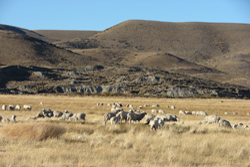The researchers proposed a method that allocates environmental impact on the basis of the protein requirements for wool and meat production. "As both meat and wool are protein-based products, and wool production is largely determined by protein requirements, this is a logical basis for allocation," they suggested.
Dr Paul Swan, general manager research at AWI and chair of the IWTO’s Sustainable Practices Working Group said: "As a tool, LCA has its limitations. A lot of the time these limitations relate to assumptions that are being used and their lack of consistency. Many of the assumptions that are currently used for basic LCA are very unhelpful for wool. This research exposes some of the weaknesses in the system.”
"Based on these findings, we could expect to see very different environmental impacts attributable to wool if we study a change in wool production compared to simply looking at historical averages," added the study's lead author Stephen Wiedemann.
We approached Made-By with these findings, and asked whether it might consider re-thinking how it ‘scores’ wool in its Environmental Benchmark. Made-By told us: “Whilst the steering committee will guide the final direction of the Fibre Benchmark [which is currently under consideration] our current understanding is that both ISO and the FAO’s Livestock Environmental Assessment and Performance (LEAP) methodology guidelines generally prefer economic allocation of environmental burdens between co-products in these scenarios. [editor’s note: LEAP Guidelines for small ruminants (sheep and goats) recommends biophysical allocation for the sheep farm stage but economic for subsequent stages.] This represents the intention behind production (i.e. to supply a demand for different products, for example rearing sheep for wool and meat) and can be applicable to different cases where co-products are closely coupled or uncoupled (i.e. sheep rearing will result in both wool and meat whereas wood pulp processing could be exclusively focused on viscose production or other products).
“The research paper [mentioned above] recommends that regardless of allocation method chosen, results should be presented for all co-products to avoid risks of burden shifting. Whilst this can be done in an academic context, it is usually less practical in industry applications; particularly as the focus of the Fibre Benchmark and other industry tools is informed decision-making for brands and retailers. Because of this, allocation must be completed to model the impacts of co-products which are in scope of our tools, and it would be impractical to add products such as meat or cottonseed oil. In addition, the majority of existing LCAs adopt methodologies that use economic allocation, and as such applying varying methodologies for different fibres could risk making the results incompatible with each other. Maintaining equivalent allocation assessment methodologies for different fibres also ensures a ‘level playing field’ and more readily allows direct comparison between fibres …”
One might deduce from this response that wool simply does not fit readily into Made-By’s scoring tool – which could, in turn, mean that attempting a direct comparison with other fibres may lead to misleading guidance for brands and consumers. We put this point to Beverley Henry, who also chairs the AWI Wool LCA TAG and was the co-author of the allocation paper cited in this article.







